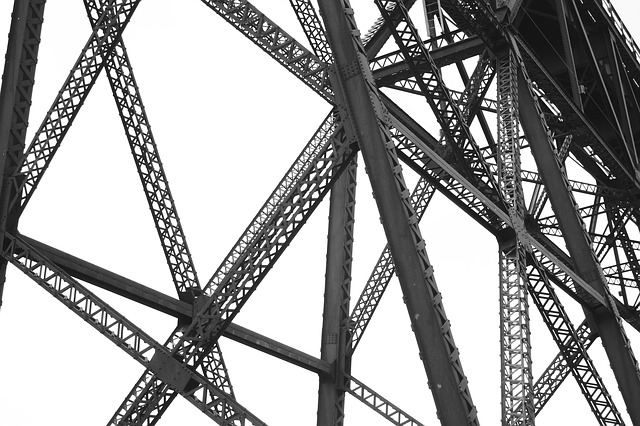Types of steel for construction

|
Contents |
[edit] Introduction
Steel is one of the most commonly used materials in civil engineering due to its high strength, durability and relatively low cost. It is an alloy of iron and a number of other elements including carbon. Manufacturers produce different types of steel by varying the type and quantity of alloy components, as well as the production process and the manner in which they are worked.
The different mechanical and physical properties that are required for the specific application determine the type of steel that is produced. Grading systems identify steels based on properties such as:
- Elasticity.
- Density.
- Melting point.
- Thermal conductivity.
- Strength.
- Hardness.
There are many different types of steel, broadly categorised according to their chemical composition into the following groups:
[edit] Carbon steel
Carbon steel is a combination of iron and carbon. The percentage of carbon is varied to produce different qualities of steel. The higher the level of carbon, the stronger, but more brittle the steel tends to be:
- Low carbon steel is easily workable. Wrought iron is a form of low carbon steel, often used for decorative ironwork such as railings and gates.
- Medium carbon steel can be used for structural steelwork.
- High carbon steel is often used for the manufacture of tools and high-strength wire.
- Ultra-high carbon steel is non-malleable, hard and brittle. Cast iron is a form of ultra-high carbon steel.
[edit] Alloy steel
Alloy steels are produced from carbon steel and one or more alloying elements. These additions can improve the mechanical properties of the alloy. For example, steel combined with manganese is very hard and strong, while steel combined with aluminium is more uniform in appearance.
Weathering steel (also known by the trademark COR-TEN steel) is a form of high-strength, low alloy steel, chemically composed to form a stable, rust-like appearance that can resist corrosion and abrasion, by forming a protective surface layer, or patina.
Steel combined with chromium (and sometimes nickel) is called stainless steel. Stainless steels do not generally form rust on their surfaces and do not discolour. The level of chromium is typically between 10-20%, with a level of 11% making the steel around 200 times more corrosion resistant than steels that contain no chromium. Stainless steel can be classified into three main categories based on their metallurgical structure: austenitic, ferritic and martensitic. For more information, see Stainless steel.
Tool steels are steels containing varying amounts of tungsten, molybdenum, cobalt and vanadium that have properties that are particularly suitable for forming tools and can be used to create moulds for injection moulding. They are abrasion, impact and/or corrosion resistant.
[edit] Galvanised steel
Galvanisation can be used to help prevent steel from corroding. This involves coating steel in zinc. The coating of zinc prevents corrosive substances from reaching the base metal. The zinc also acts as a sacrificial anode, meaning that if the coating is scratched, the remaining zinc will still protect the exposed steel.
[edit] Related articles on Designing Buildings
Featured articles and news
RTPI leader to become new CIOB Chief Executive Officer
Dr Victoria Hills MRTPI, FICE to take over after Caroline Gumble’s departure.
Social and affordable housing, a long term plan for delivery
The “Delivering a Decade of Renewal for Social and Affordable Housing” strategy sets out future path.
A change to adoptive architecture
Effects of global weather warming on architectural detailing, material choice and human interaction.
The proposed publicly owned and backed subsidiary of Homes England, to facilitate new homes.
How big is the problem and what can we do to mitigate the effects?
Overheating guidance and tools for building designers
A number of cool guides to help with the heat.
The UK's Modern Industrial Strategy: A 10 year plan
Previous consultation criticism, current key elements and general support with some persisting reservations.
Building Safety Regulator reforms
New roles, new staff and a new fast track service pave the way for a single construction regulator.
Architectural Technologist CPDs and Communications
CIAT CPD… and how you can do it!
Cooling centres and cool spaces
Managing extreme heat in cities by directing the public to places for heat stress relief and water sources.
Winter gardens: A brief history and warm variations
Extending the season with glass in different forms and terms.
Restoring Great Yarmouth's Winter Gardens
Transforming one of the least sustainable constructions imaginable.
Construction Skills Mission Board launch sector drive
Newly formed government and industry collaboration set strategy for recruiting an additional 100,000 construction workers a year.
New Architects Code comes into effect in September 2025
ARB Architects Code of Conduct and Practice available with ongoing consultation regarding guidance.
Welsh Skills Body (Medr) launches ambitious plan
The new skills body brings together funding and regulation of tertiary education and research for the devolved nation.
Paul Gandy FCIOB announced as next CIOB President
Former Tilbury Douglas CEO takes helm.
UK Infrastructure: A 10 Year Strategy. In brief with reactions
With the National Infrastructure and Service Transformation Authority (NISTA).






















